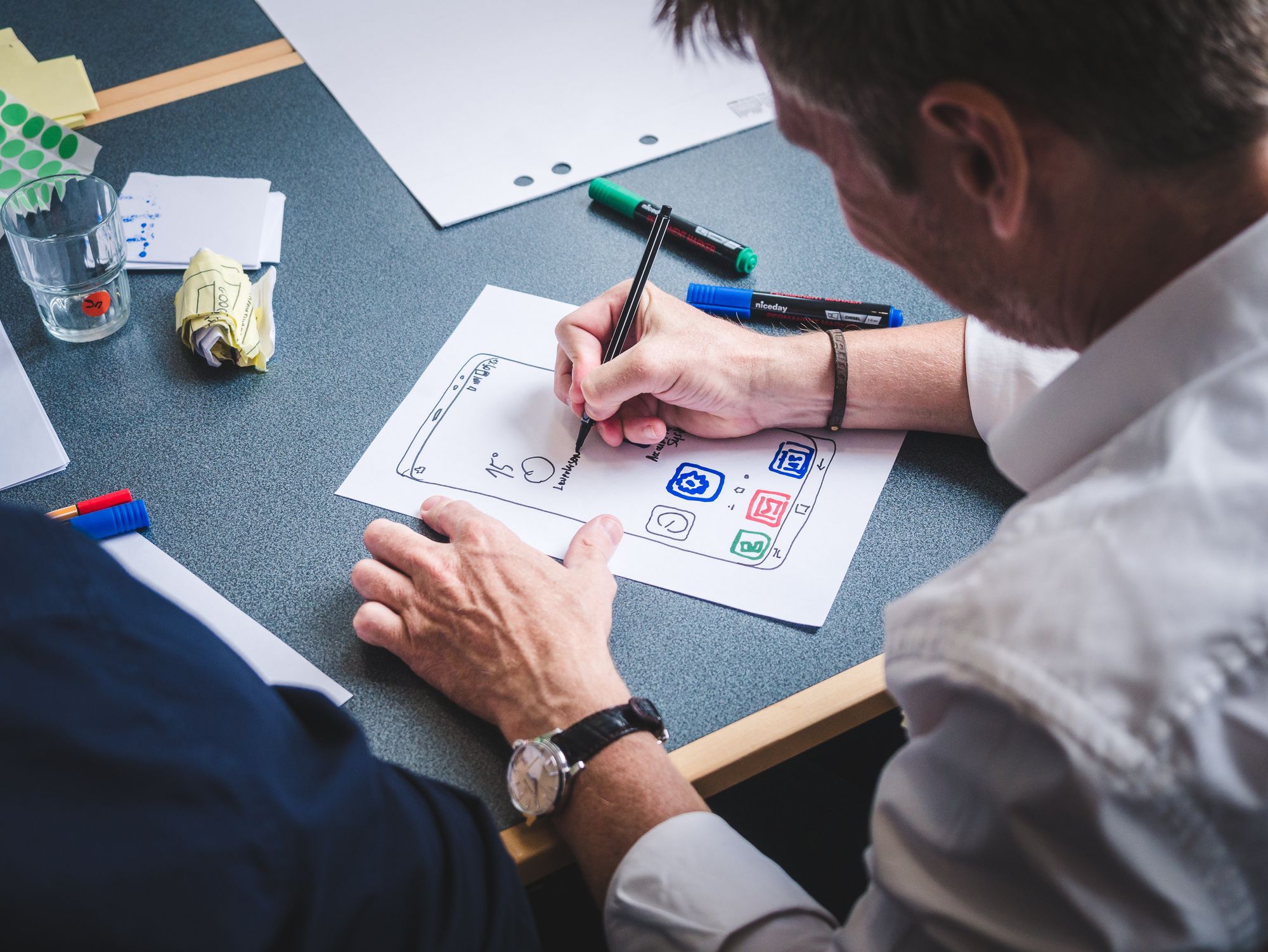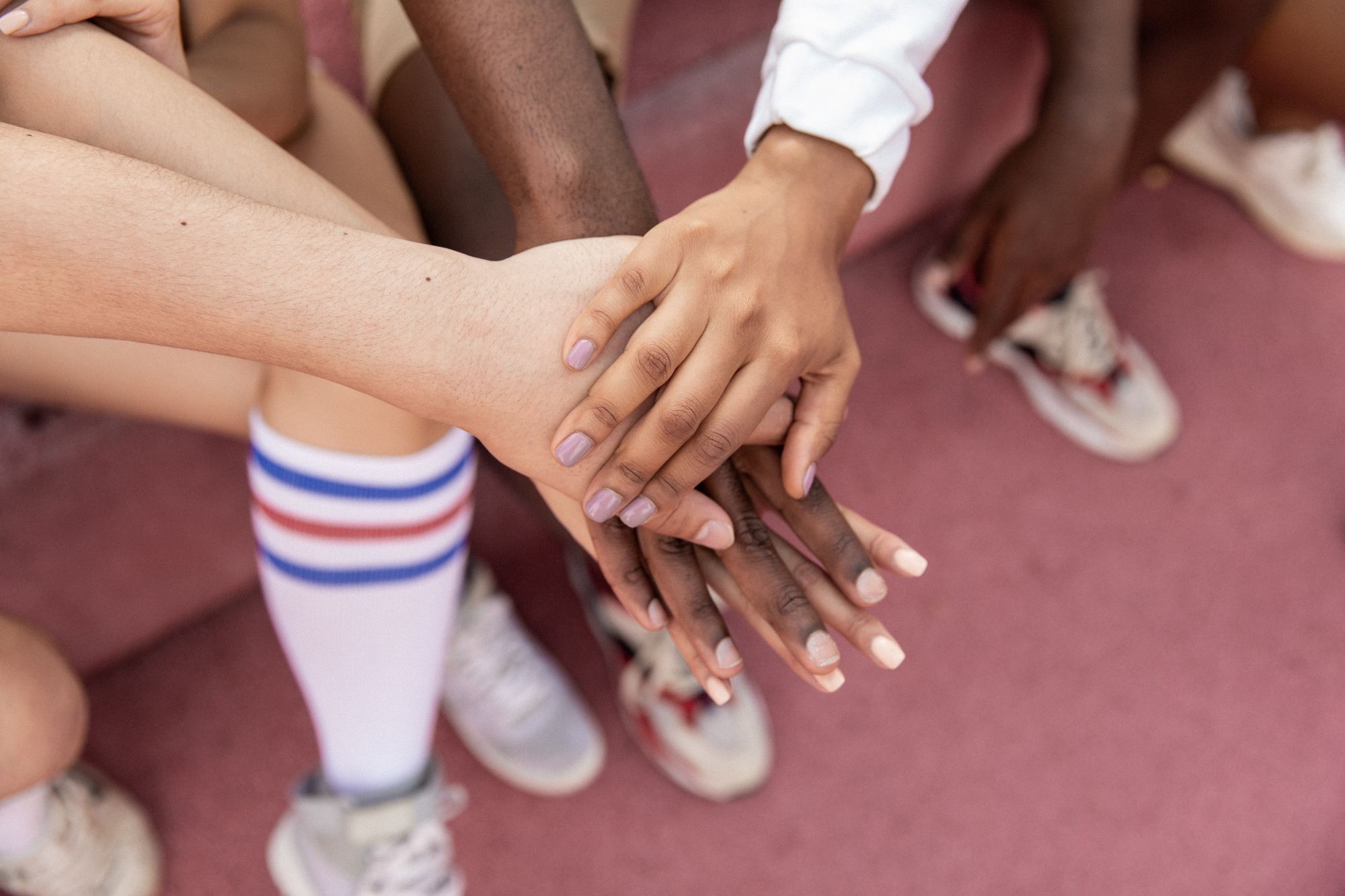
An Introduction to Human-Centered Design
Whether you're a designer, developer, or business leader, HCD can help you deliver more relevant and delightful customer experiences.
Design isn't just about creating pretty things, it's about solving real problems for real people. That's why human-centered design (HCD) is so important. By starting with the needs of your audience, you can create products, experiences, and services that truly resonate with them.
HCD is a creative approach to problem-solving that has been used by some of the world's most successful companies, like IDEO. It begins with identifying the needs of your audience, and then using those needs to guide the design process. The result? Solutions that are not only effective but also meaningful and memorable.
Whether you're a designer, developer, or business leader, HCD can help you deliver more relevant and delightful customer experiences. It's not just a buzzword, it's a powerful tool that can drive business value and set you apart from your competitors.
So if you're looking to improve your business or organization, don't overlook the power of human-centered design. By putting people first, you can create solutions that truly make a difference.
At the heart of HCD is people. It's all about understanding their goals, feelings, and experiences throughout the process. By putting people first, we can develop solutions that truly address their problems and make a meaningful impact.
To be effective, HCD solutions must be desirable, feasible, and viable. That means they must meet the needs of the people who will use them, be possible to build, and fit within the business model of the organization. When these criteria are met, HCD can truly shine.
Two areas where HCD has been particularly successful are user experience (UX) design and service design. These practices focus on creating meaningful and consistent experiences for users and customers across multiple interactions. HCD methods have been applied to these fields for years, resulting in products and services that truly resonate with people.
But the next chapter of design history is pushing HCD to go even further. Relationship design is all about understanding how people are connected to each other and their communities over time. By creating experiences that foster ongoing engagement and strengthen connections, we can build stronger, more meaningful relationships between people, companies, and communities.
At its core, HCD is about putting people first. Whether you're designing a product, a service, or a relationship, the principles of HCD can help you create solutions that truly make a difference in people's lives.
In this module, we explore the evolution of HCD and how it has led to the development of Relationship Design. We discuss how design can be used to strengthen relationships of all kinds and provide core mindsets that can be put into practice regardless of your role or function. By adopting these mindsets, you can create solutions that strengthen relationships and drive business value.
Before we move on, let's examine how Relationship Design extends the principles of UX and service design in HCD.
User Experience (UX) Design
UX design is all about creating a seamless and satisfying experience for users of a product, especially digital ones. Imagine you're headed to the airport for a long-awaited vacation. Your airline sends you an email reminding you to check in. You click the link in the email and voila, the check-in page appears. A big, friendly "Check In" button greets you. You click it and just like that, you're offered the option to download your boarding pass. A few taps on your screen and you're ready to take off. That's what a great UX design can do for you.

But for a UX designer, even the most seamless user experience can always be improved. What if, instead of an email, you received a text message from your airline prompting you to reply with "1" to check in and "2" to decline? When you respond with "1," the system sends you a QR code boarding pass - no clicking required.
The underlying principle of UX design is that the value of a product can be elevated when it's tailored to the experiences of its users. Through a deep understanding of aesthetics, behavior, technology, and environment, UX design aims to respond to user behavior and guide them toward specific outcomes. This involves ensuring that a product is easy to use, allowing for quick task completion, and enjoyable to interact with.
Service Design
In the world of design, service design is the next level up from UX design. While UX focuses on a product's user experience, service design takes a holistic approach by looking at all the touchpoints between a person and a company. That means paying attention to the customer's journey from start to finish and ensuring that every interaction is optimized for their benefit.
So, let's return to the airport example. The easy and seamless online check-in process is just one part of the larger service experience. From checking in bags to ordering beverages and navigating in-flight entertainment, each step of the journey contributes to the overall experience. And service design aims to make every step a delight for the customer.
The goal of service design is to create a consistent, enjoyable experience for customers across all these touchpoints.
In the world of design, UX reigns supreme when it comes to creating digital products that people love to use. But what happens when a person's interaction with a company extends beyond a single product? That's where service design comes in.
Service design looks at the bigger picture of a customer's journey, taking into account all the different touchpoints they have with a company. From checking in for a flight to ordering a drink on the plane, to finally arriving at your destination, every interaction counts.

The goal of service design is to create a consistent, enjoyable experience for customers across all these touchpoints. This involves looking at everything from online interactions to in-person experiences, and even the systems and processes that a company uses to deliver those experiences.
Service design focuses on:
Making it easy for customers to accomplish their goals, whether they're online or in person.
Ensuring that the brand experience is consistent across all interactions, regardless of the channel.
Creating an organizational structure that supports the delivery of exceptional experiences to customers.
Relationship Design
Imagine you’re designing a product or service, and you want to create a meaningful impact on people’s lives. You’ve already considered the user experience, the service design, and now you’re ready to take it to the next level. That’s where Relationship Design comes in.
Relationship Design goes beyond individual interactions and considers the relationships people have with others, communities, and the planet. It’s about creating a positive impact that extends beyond the individual user and their experience.

When designing for relationships, you want to focus on three key goals: Engagement, Connection, and Social Values.
Engagement is about creating experiences that encourage ongoing engagement with your brand. It’s about building a connection between your product or service and your customers so that they keep coming back.
Connection is about fostering relationships between individuals, communities, and your brand. It’s about building connections that go beyond just the individual user and creating a sense of belonging.
Social Values are about considering the impact your product or service has on society as a whole. It’s about making sure that your solution is inclusive, sustainable, and ethical.
By designing for relationships, companies can create experiences that go beyond just transactional interactions with customers.
By designing with inclusivity, sustainability, and ethics in mind, you can create solutions that truly make a positive impact on people’s lives. It’s about finding the sweet spot where desirability, feasibility, and viability intersect with inclusivity, sustainability, and ethics. When you achieve this, you can create products and services that not only meet the needs of individuals but also contribute to a better world for all.
By designing for relationships, companies can create experiences that go beyond just transactional interactions with customers. These experiences can create lasting connections and even inspire loyalty. The focus is on engagement, connection, and social values.
The goal of Relationship Design is to ensure that products and services are inclusive, sustainable, and ethical. When a company designs with these values in mind, it can become a force for good in the world, and also create long-term relevance in the market.
Let's look at an example. When you're traveling, there are many opportunities to design an experience that supports relationships. For instance, the airline could allow you to enter the flight confirmation numbers of your fellow travelers, so that you're automatically assigned seats next to each other. Nonbinary gender options can be provided for travelers who identify as gender-nonconforming. The airline could also create ways to find connections with fellow passengers or engage with loved ones on the ground. And for those who are concerned about the environmental impact of air travel, the airline can provide ways to offset their carbon footprint.
If a customer is still dissatisfied with some aspect of the service, they can join the Customer Committee to help co-create better experiences for everyone. By focusing on these types of relationship-building strategies, companies can create experiences that truly matter to their customers and communities. Designing for customer relationships involves creating experiences that foster trust and loyalty between customers and the brand. This includes everything from personalized marketing to responsive customer support.

Designing for community relationships requires a deep understanding of the culture, values, and needs of the community. Whether it’s a local neighborhood or a global network, design can facilitate connection, belonging, and social impact.
Designing for relationships with the planet requires a holistic approach to sustainability. This includes everything from reducing waste and carbon emissions to creating products and services that support a regenerative economy.
By designing for these different types of relationships, organizations can create meaningful connections with their customers, communities, and the planet. And by doing so, they can create a positive impact in the world while building a thriving business.
Design isn't just about creating pretty things, it's about solving real problems for real people. That's why human-centered design (HCD) is so important. By starting with the needs of your audience, you can create products, experiences, and services that truly resonate with them.
HCD is a creative approach to problem-solving that has been used by some of the world's most successful companies, like IDEO. It begins with identifying the needs of your audience, and then using those needs to guide the design process. The result? Solutions that are not only effective but also meaningful and memorable.
Whether you're a designer, developer, or business leader, HCD can help you deliver more relevant and delightful customer experiences. It's not just a buzzword, it's a powerful tool that can drive business value and set you apart from your competitors.
So if you're looking to improve your business or organization, don't overlook the power of human-centered design. By putting people first, you can create solutions that truly make a difference.
At the heart of HCD is people. It's all about understanding their goals, feelings, and experiences throughout the process. By putting people first, we can develop solutions that truly address their problems and make a meaningful impact.
To be effective, HCD solutions must be desirable, feasible, and viable. That means they must meet the needs of the people who will use them, be possible to build, and fit within the business model of the organization. When these criteria are met, HCD can truly shine.
Two areas where HCD has been particularly successful are user experience (UX) design and service design. These practices focus on creating meaningful and consistent experiences for users and customers across multiple interactions. HCD methods have been applied to these fields for years, resulting in products and services that truly resonate with people.
But the next chapter of design history is pushing HCD to go even further. Relationship design is all about understanding how people are connected to each other and their communities over time. By creating experiences that foster ongoing engagement and strengthen connections, we can build stronger, more meaningful relationships between people, companies, and communities.
At its core, HCD is about putting people first. Whether you're designing a product, a service, or a relationship, the principles of HCD can help you create solutions that truly make a difference in people's lives.
In this module, we explore the evolution of HCD and how it has led to the development of Relationship Design. We discuss how design can be used to strengthen relationships of all kinds and provide core mindsets that can be put into practice regardless of your role or function. By adopting these mindsets, you can create solutions that strengthen relationships and drive business value.
Before we move on, let's examine how Relationship Design extends the principles of UX and service design in HCD.
User Experience (UX) Design
UX design is all about creating a seamless and satisfying experience for users of a product, especially digital ones. Imagine you're headed to the airport for a long-awaited vacation. Your airline sends you an email reminding you to check in. You click the link in the email and voila, the check-in page appears. A big, friendly "Check In" button greets you. You click it and just like that, you're offered the option to download your boarding pass. A few taps on your screen and you're ready to take off. That's what a great UX design can do for you.

But for a UX designer, even the most seamless user experience can always be improved. What if, instead of an email, you received a text message from your airline prompting you to reply with "1" to check in and "2" to decline? When you respond with "1," the system sends you a QR code boarding pass - no clicking required.
The underlying principle of UX design is that the value of a product can be elevated when it's tailored to the experiences of its users. Through a deep understanding of aesthetics, behavior, technology, and environment, UX design aims to respond to user behavior and guide them toward specific outcomes. This involves ensuring that a product is easy to use, allowing for quick task completion, and enjoyable to interact with.
Service Design
In the world of design, service design is the next level up from UX design. While UX focuses on a product's user experience, service design takes a holistic approach by looking at all the touchpoints between a person and a company. That means paying attention to the customer's journey from start to finish and ensuring that every interaction is optimized for their benefit.
So, let's return to the airport example. The easy and seamless online check-in process is just one part of the larger service experience. From checking in bags to ordering beverages and navigating in-flight entertainment, each step of the journey contributes to the overall experience. And service design aims to make every step a delight for the customer.
The goal of service design is to create a consistent, enjoyable experience for customers across all these touchpoints.
In the world of design, UX reigns supreme when it comes to creating digital products that people love to use. But what happens when a person's interaction with a company extends beyond a single product? That's where service design comes in.
Service design looks at the bigger picture of a customer's journey, taking into account all the different touchpoints they have with a company. From checking in for a flight to ordering a drink on the plane, to finally arriving at your destination, every interaction counts.

The goal of service design is to create a consistent, enjoyable experience for customers across all these touchpoints. This involves looking at everything from online interactions to in-person experiences, and even the systems and processes that a company uses to deliver those experiences.
Service design focuses on:
Making it easy for customers to accomplish their goals, whether they're online or in person.
Ensuring that the brand experience is consistent across all interactions, regardless of the channel.
Creating an organizational structure that supports the delivery of exceptional experiences to customers.
Relationship Design
Imagine you’re designing a product or service, and you want to create a meaningful impact on people’s lives. You’ve already considered the user experience, the service design, and now you’re ready to take it to the next level. That’s where Relationship Design comes in.
Relationship Design goes beyond individual interactions and considers the relationships people have with others, communities, and the planet. It’s about creating a positive impact that extends beyond the individual user and their experience.

When designing for relationships, you want to focus on three key goals: Engagement, Connection, and Social Values.
Engagement is about creating experiences that encourage ongoing engagement with your brand. It’s about building a connection between your product or service and your customers so that they keep coming back.
Connection is about fostering relationships between individuals, communities, and your brand. It’s about building connections that go beyond just the individual user and creating a sense of belonging.
Social Values are about considering the impact your product or service has on society as a whole. It’s about making sure that your solution is inclusive, sustainable, and ethical.
By designing for relationships, companies can create experiences that go beyond just transactional interactions with customers.
By designing with inclusivity, sustainability, and ethics in mind, you can create solutions that truly make a positive impact on people’s lives. It’s about finding the sweet spot where desirability, feasibility, and viability intersect with inclusivity, sustainability, and ethics. When you achieve this, you can create products and services that not only meet the needs of individuals but also contribute to a better world for all.
By designing for relationships, companies can create experiences that go beyond just transactional interactions with customers. These experiences can create lasting connections and even inspire loyalty. The focus is on engagement, connection, and social values.
The goal of Relationship Design is to ensure that products and services are inclusive, sustainable, and ethical. When a company designs with these values in mind, it can become a force for good in the world, and also create long-term relevance in the market.
Let's look at an example. When you're traveling, there are many opportunities to design an experience that supports relationships. For instance, the airline could allow you to enter the flight confirmation numbers of your fellow travelers, so that you're automatically assigned seats next to each other. Nonbinary gender options can be provided for travelers who identify as gender-nonconforming. The airline could also create ways to find connections with fellow passengers or engage with loved ones on the ground. And for those who are concerned about the environmental impact of air travel, the airline can provide ways to offset their carbon footprint.
If a customer is still dissatisfied with some aspect of the service, they can join the Customer Committee to help co-create better experiences for everyone. By focusing on these types of relationship-building strategies, companies can create experiences that truly matter to their customers and communities. Designing for customer relationships involves creating experiences that foster trust and loyalty between customers and the brand. This includes everything from personalized marketing to responsive customer support.

Designing for community relationships requires a deep understanding of the culture, values, and needs of the community. Whether it’s a local neighborhood or a global network, design can facilitate connection, belonging, and social impact.
Designing for relationships with the planet requires a holistic approach to sustainability. This includes everything from reducing waste and carbon emissions to creating products and services that support a regenerative economy.
By designing for these different types of relationships, organizations can create meaningful connections with their customers, communities, and the planet. And by doing so, they can create a positive impact in the world while building a thriving business.


